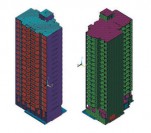Computational and Experimental Simulation of Tall Building Vibrations

Significant and dangerous (to human health) vibrations in tall and high-rise buildings may have different “nature”: wind effect, plant operation (elevators, pumps, etc.) and transport traffic, including metro lines in the “area of influence”. In this article we will focus on the latter one and illustrate the problem and ways of its solution by the example of a designed being under construction high-rise building, for which the question came up if a system of vibration insulation should be implemented or not.
It should be noted that no adequate method of evaluation of building vibration response had been developed until then, which resulted in serious arbitrariness in selection and types of quite expensive vibration insulation efforts at design and construction stages. This article presents the results of methodological investigations and computational experimental studies of bearing structure vibrations in bulks under construction and erected bulks of highrise buildings induced by metro train traffic.
Description of study subject
The bulk of a residential complex in the area of “transport” vibration influence (Moscow, Vernadsky prospect, near the “University” metro station) is studied. It is a building under construction with a varying number of storeys (11-19 floors above the ground + mechanical floor) consisting of 12 sections. The substructure of 7th to 12th sections is provided for a parking lot (2 floors + mechanical floor). The substructure of 1st to 6th sections is provided for a mechanical floor. Sections are separated by expansion joints.
The bearing structure of a building section is designed as a jointless spatial frame comprising a conjunction of foundations, columns, walls and stairwell cores rigidly connected to floor slabs. As envisioned by designers, spatial combined action of building structures aimed at design combination of vertical and horizontal loads provides rather uniform base settlement, standard deflection of floor slabs and allowable crack growth. All main bearing structures are made of insitu reinforced concrete of grade B25, B30 (columns) complete with reinforcing bars of grade A500SP, AI and rigidly interconnected at junction nodes.
Full content of this issue you can read here
The full version of the article can be read in our printed issue, also you can subscribe to the web-version of the magazine
 Text by: Alexander Belostotsky, director general of STADYO R&D, the head of REC CM MGSU, associate member of RAASN, D.Sc. in engineering, professor; research associates at the research and educational center of computer simulation at MSUCE A.A. Aul, A.I.Nagibovich
Text by: Alexander Belostotsky, director general of STADYO R&D, the head of REC CM MGSU, associate member of RAASN, D.Sc. in engineering, professor; research associates at the research and educational center of computer simulation at MSUCE A.A. Aul, A.I.Nagibovich


